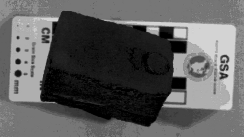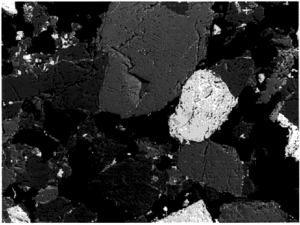Sintered Regolith
| This article is incomplete or needs more information. You can help Lunarpedia by expanding or correcting it. |
Sintered regolith falls into the category of ceramic materials as sintering is the process most common to ceramics. When bricks are made from clay on Earth, first the bricks are heated long enough and hot enough to drive out the water. Then the heating is increased to cause partial melting or vitrification which results in the edges of adjacent grains being bonded together once they have cooled. The unmelted particles provide a stable shape and size during the process which involves some shrinkage and a decrease in porosity.
Lunar Considerations
On Luna water for mixing the various particles would be very expensive and recycling the water would never be 100% effective. It has been demonstrated that the sintering of dry regolith simulant will provide satisfactory bricks, and there is the example of mixing dry powders for powder metallurgy, which is a sintering process performed on Earth and involves putting the material under pressure. Compaction of lunar simulant using vibration has been demonstrated by NASA, but this method may not be as effective or may require more time in the reduced gravity of the moon. More will be known about the quality of bricks possible from lunar materials when the research can be done on Luna. A possibility to consider is the sintering of bricks in an oxygen atmosphere as opposed to in a vacuum. Fine particles in an insulating vacuum have the tendency to stick together due to friction which generates a static charge between adjacent, non-conducting particles. Sintering regolith in an oxygen atmosphere has the potential to provide an atmospheric ground but may also result in a loss of oxygen due to oxidation. However, oxygen is plentiful on Luna and experimentation will show if there is benefit to balance the cost. Some low partial pressure of oxygen could conceivably be found best for the process of sintering bricks. Another alternative is the use of a hydrogen atmosphere which results in a net gain of oxygen and will be discussed later.
Radiant Heating
Experiments in radiant heating of regolith simulant have been carried out by NASA Johnson Space Center and Lockheed Engineering & Sciences Co. Results show that radiant heating can reproducibly sinter large, strong bricks in a fused silica mold. Fused silica was chosen for its combination of extremely low thermal conductivity and low density.
Uniform bricks measuring 7.9 x 5.5 x 3.6 cm were produced by heating MLS-1 Basalt for two hours at 1,100 degrees Celsius. Resulting bricks were crack free except for small expansion cracks near the top surface, with negligible reductions in volume and density.
Larger bricks were produced from the glass-rich simulant JSC-1. The sample was initially compacted using vibration for 5 minutes until reaching 2.45 grams/cm3, and then sintered for 2.5 hours at 1,100 degrees Celsius. A silica fabric liner was inserted between the simulant and the fused silica mold to prevent the brick from sintering to the mold.
Microwave Heating
In experiments, pure microwave heating has been unsuccessful in producing usable bricks. Due to the thermal insulating properties of crushed lunar regolith and it's simulants, the insides of the bricks melt while the outside remains unsintered. While not useful for this purpose, microwave heating may be found useful for foundation preparation, permanent grading, road construction, dust remediation, and applications for which molten regolith is required.
Was totlaly stuck until I read this, now back up and running.
External Links
- Construction Materials for Planetary Outposts: A Review - LPI .. PDF
- Lunar Regolith Simulant Materials: Recommendations for Standardization, Production and Usage - NASA MSFC .. PDF
- Sintering of Lunar and Asteroidal Material - PERMANENT
- Structural Design of a Lunar Habitat - Journal of Aerospace Engineering, July 2006, pg 137 .. PDF
- Workshop on using In-Situ resources for construction of planetary outposts - LPI .. PDF
- Sintering Bricks on the Moon - NASA JSC
- Vacuum Pyrolysis and Related ISRU Techniques - NASA GSFC .. PDF








